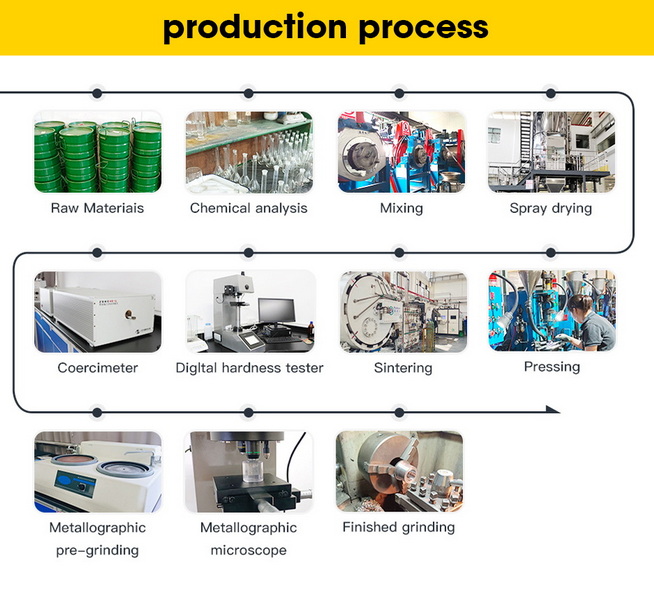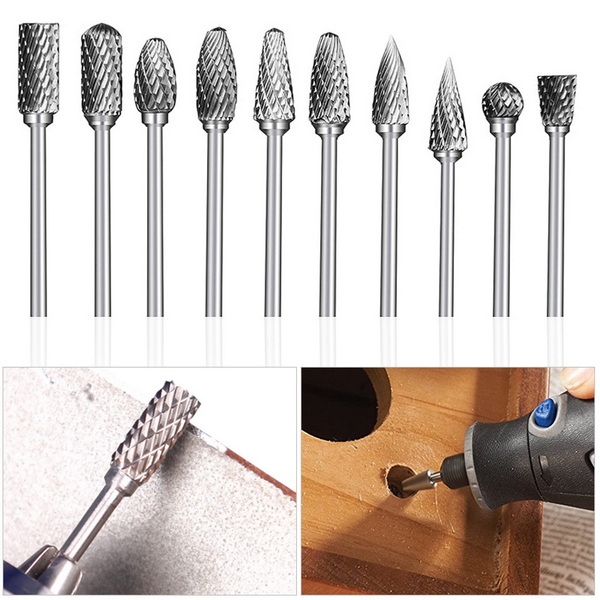Content Menu
● Materials Used
● Manufacturing Process
● Detailed Steps with Illustrations
>> Step 1: Powder Preparation and Mixing
>> Step 2: Milling
>> Step 3: Compaction
>> Step 4: Sintering
>> Step 5: Grinding and Shaping
>> Step 6: Coolant Hole Drilling (if applicable)
>> Step 7: Coating (Optional)
>> Step 8: Final Inspection and Testing
● Quality Control
● Advanced Techniques
● Benefits of Tungsten Carbide Drill Bits
● Conclusion
● FAQ
>> 1. What is tungsten carbide?
>> 2. Why is cobalt used as a binder in tungsten carbide drill bits?
>> 3. What are the benefits of using coolant holes in drill bits?
>> 4. What types of coatings are commonly used on tungsten carbide drill bits?
>> 5. How should tungsten carbide drill bits be maintained to prolong their lifespan?
● Citations:
Tungsten carbide drill bits are essential tools in various industries, known for their hardness, wear resistance, and ability to drill through tough materials[1]. Understanding how these drill bits are made involves a detailed look at the materials, manufacturing processes, and quality control measures[1].

Materials Used
The primary material in tungsten carbide drill bits is, of course, tungsten carbide. Tungsten carbide is a compound of tungsten and carbon, known for its exceptional hardness and wear resistance. It is typically used in powder form and mixed with a binder, usually cobalt[1]. Cobalt acts as a matrix to hold the tungsten carbide particles together[1].
Manufacturing Process
The manufacturing of tungsten carbide drill bits involves several key steps:
1.Powder Preparation:
Tungsten carbide powder is mixed with cobalt powder in precise proportions. The ratio of tungsten carbide to cobalt can vary depending on the desired properties of the final product[1].
2.Milling:
The powder mixture is then milled to ensure a homogenous blend. Milling helps to break down any agglomerates and evenly distribute the cobalt binder throughout the tungsten carbide powder[1].
3. Compaction:
The mixed powder is compacted into the desired shape of the drill bit using high pressure. This can be achieved through various methods, including uniaxial pressing, isostatic pressing, or extrusion[1].
4. Sintering:
The compacted part is then sintered in a controlled atmosphere furnace. Sintering involves heating the part to a high temperature, typically between 1300 and 1600 degrees Celsius, which causes the cobalt binder to melt and coalesce, bonding the tungsten carbide particles together[3][5].
5. Grinding and Shaping:
After sintering, the drill bit blank is hard but not yet to its final dimensions or shape. Grinding is used to achieve the required precision and surface finish. Diamond grinding wheels are commonly used due to the hardness of tungsten carbide[1][7].
6. Coolant Hole Drilling (if applicable):
For drill bits with coolant holes, a small hole is drilled through the center of the bit using specialized equipment. This hole allows coolant to be delivered directly to the cutting edge, reducing heat and improving drilling performance[1].
7. Coating (Optional):
To further enhance the performance and lifespan of the drill bit, a coating may be applied. Common coatings include titanium nitride (TiN), titanium carbonitride (TiCN), and diamond-like carbon (DLC)[1]. These coatings improve wear resistance, reduce friction, and prevent material buildup on the cutting edge[1].
8. Final Inspection:
The finished drill bit is inspected for dimensional accuracy, surface finish, and any defects. This ensures that the drill bit meets the required specifications and quality standards[1].
Detailed Steps with Illustrations
Step 1: Powder Preparation and Mixing
The first step in manufacturing tungsten carbide drill bits is the careful preparation and mixing of the raw materials. Tungsten carbide powder, known for its extreme hardness, is combined with cobalt powder, which acts as a binder[1]. The precise ratio of these materials is crucial, as it directly impacts the final hardness, toughness, and wear resistance of the drill bit[1].
Step 2: Milling
The mixed powder undergoes milling to ensure uniformity. This process involves grinding the powder in a ball mill or other milling equipment to break down agglomerates and ensure an even distribution of cobalt throughout the tungsten carbide[1]. Uniformity in the powder mixture is essential for consistent sintering and achieving the desired mechanical properties[1].
Step 3: Compaction
The homogenous powder mixture is then compacted into the shape of a drill bit. Compaction is typically done using high-pressure pressing techniques such as uniaxial pressing or isostatic pressing[1]. Uniaxial pressing involves applying pressure in one direction, while isostatic pressing applies pressure uniformly from all directions, resulting in a more consistent density[1].
Step 4: Sintering
Sintering is a critical step in the manufacturing process. The compacted drill bit blank is placed in a controlled atmosphere furnace and heated to a high temperature, usually between 1300°C and 1600°C[3][5]. At this temperature, the cobalt binder melts and flows between the tungsten carbide particles, bonding them together[3][5]. The controlled atmosphere prevents oxidation and other unwanted reactions, ensuring the final product has the desired properties[3][5].
Step 5: Grinding and Shaping
After sintering, the drill bit is extremely hard but requires precise shaping and finishing. Grinding is performed using diamond grinding wheels, which are capable of machining the hard tungsten carbide material[1][7]. CNC (Computer Numerical Control) grinding machines are used to achieve the tight tolerances and complex geometries required for high-performance drill bits[1][7].
Step 6: Coolant Hole Drilling (if applicable)
For drill bits designed with coolant channels, a small hole is drilled through the center of the bit[1]. This requires specialized drilling equipment and techniques to maintain precision and prevent damage to the drill bit[1]. The coolant hole allows cutting fluid to be delivered directly to the cutting edge, reducing heat and improving chip evacuation[1].
Step 7: Coating (Optional)
To enhance wear resistance and reduce friction, tungsten carbide drill bits are often coated with materials such as titanium nitride (TiN) or titanium carbonitride (TiCN)[1]. These coatings are applied using Physical Vapor Deposition (PVD) or Chemical Vapor Deposition (CVD) processes, which create a thin, hard layer on the surface of the drill bit[1].
Step 8: Final Inspection and Testing
The final step is a thorough inspection to ensure that the drill bit meets all required specifications. This includes dimensional checks, surface finish analysis, and testing for hardness and wear resistance[1]. Drill bits that pass inspection are then packaged and shipped to customers[1].

Quality Control
Quality control is paramount in the manufacturing of tungsten carbide drill bits. It begins with the selection of high-quality raw materials and continues through every stage of the production process[1]. Regular inspections, testing, and process monitoring are conducted to ensure that the drill bits meet the required standards[1].
Advanced Techniques
Layered Manufacturing: In some advanced methods, layered manufacturing is used to create a steel powder core, which is then combined with tungsten carbide[3][5]. This allows for the creation of drill bits with a tough steel core and a wear-resistant tungsten carbide exterior[3][5].
Erosion-Resistant Materials: To improve the longevity of drill bits, erosion-resistant materials like tungsten carbide (WC) are used in areas prone to wear[3][5]. These materials are often applied as coatings or inserts to protect the drill bit from abrasion and erosion[3][5].
Benefits of Tungsten Carbide Drill Bits
- High Hardness: Tungsten carbide is exceptionally hard, allowing the drill bits to cut through tough materials[1].
- Wear Resistance: These drill bits can withstand high temperatures and abrasive conditions[1].
- Precision: The manufacturing process allows for precise shaping and dimensional accuracy[1].
- Long Lifespan: With proper care and maintenance, tungsten carbide drill bits can last a long time[1].
Conclusion
The manufacturing of tungsten carbide drill bits is a complex process that requires careful control of materials, processes, and quality[1]. From powder preparation to final inspection, each step plays a critical role in determining the performance and lifespan of the drill bit[1]. By understanding the intricacies of this process, manufacturers can produce high-quality drill bits that meet the demands of various industries[1].

FAQ
1. What is tungsten carbide?
Tungsten carbide is a chemical compound containing equal parts of tungsten and carbon atoms. It is exceptionally hard and wear-resistant, making it ideal for cutting tools[1].
2. Why is cobalt used as a binder in tungsten carbide drill bits?
Cobalt acts as a binder, holding the tungsten carbide particles together. It provides toughness and strength to the drill bit, preventing it from fracturing under stress[1].
3. What are the benefits of using coolant holes in drill bits?
Coolant holes allow cutting fluid to be delivered directly to the cutting edge, reducing heat, lubricating the cutting action, and improving chip evacuation. This results in faster drilling, longer tool life, and better surface finish[1].
4. What types of coatings are commonly used on tungsten carbide drill bits?
Common coatings include titanium nitride (TiN), titanium carbonitride (TiCN), and diamond-like carbon (DLC). These coatings improve wear resistance, reduce friction, and prevent material buildup on the cutting edge[1].
5. How should tungsten carbide drill bits be maintained to prolong their lifespan?
To prolong the lifespan of tungsten carbide drill bits, it is important to use the correct cutting speeds and feeds, apply coolant properly, and regularly inspect the drill bit for wear or damage. Sharpening the drill bit when necessary can also extend its life[1].
Citations:
[1] https://applecarbidetools.com/advanced-design-and-manufacturing-of-tungsten-carbide-drills-with-coolant-holes/
[2] https://www.ee.cityu.edu.hk/~gchen/pdf/Writing.pdf
[3] https://patents.google.com/patent/EP0930949B1/en
[4] https://www.163.com/dy/article/EDIGQUV605370K28.html
[5] https://patentimages.storage.googleapis.com/cd/e7/5c/76dc0db1115344/EP0930949B1.pdf
[6] https://blog.csdn.net/qq_34917728/article/details/125122327
[7] https://www.youtube.com/watch?v=u8jLiDPIjFk
[8] https://www.csulb.edu/sites/default/files/document/2019_mini_manuscript.pdf
















